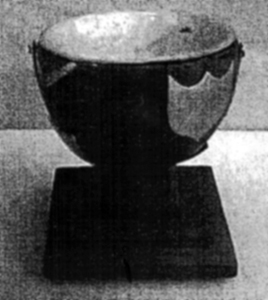"The Changi Cup was built by a member of the Royal Australian Artillery
in Changi POW Camp as a trophy for the AIF Sports Meeting held on the
padang immediately in front of the then Convalescent Depot on Christmas
Day 1942.
The materials used were limited to what was
available, some dressed timber for a base,
strips of duralumin (from aircraft wrecks) for a
metal frame to hold the cup and, the cup was a
half coconut shell dried and polished to look
pleasing.
The following information is recorded on shield
plates on the cup:
|
CHANGI POW CHALLENGE CUP
MADE AND PRESENTED BY
C. LYALL (RAA)
WON BY
2/30 BN AND 2/4 MG BN
25-12-42
CONDITIONS
5 YEARS WINS RETAINS CUP
|
 |
The Sports Meeting held at Changi on Christmas
Day 1942 was perhaps the first occasion that a
comprehensive "all in" gathering in the nature
of a morale booster was organised following the
capitulation the previous February. Many
"working parties" had already left the Changi
Camp for various places on Singapore Island and
the largest, "A Force"', had departed for Burma
to start working on the Burma/Thailand Railway,
but most units of the AIF still had a good
number of their personnel in Changi. It was
during 1943 that the further movement of large
working parties to the Burma/Thailand Railway
took place, resulting in the appalling losses of
hundreds of men before Christmas 1943.
At the conclusion of the athletic and field
events on 25th December 1942, it was announced
that the Changi Cup had been won by 2/30th
Battalion and 2/4th MG Battalion and the Cup was
duly presented to Major N. Johnston, then
administering command of the 2/30th Battalion.
There was no further opportunity during the
remaining period of captivity for the Cup to be
competed for again. By Christmas 1943 the
Selarang Barracks POW area was occupied almost
entirely by sick and wounded men representing
only small remnants of their respective units
and, by Christmas 1944, all AIF POWs that were
left at Changi were concentrated in very crowded
conditions in Changi Gaol and its immediate
environs.
In April 1943, Major Johnston left Changi in
command of the train load of POWs of "F Force"
to entrain for Thailand, and the Changi Cup was
amongst the few possessions in his officer's
steel trunk which was loaded with other baggage
at Singapore, offloaded at Bampong in Thailand,
and then left to the tender mercies of looters
on the side of the road. Nine months later when
the railway was completed the survivors of 'F
Force' were brought back to Kanchanaburi where
they stayed for up to a month awaiting orders to
entrain back to Singapore Island.
During the time spent at Kanchanaburi,
arrangements were made for officer's trunks to
be brought from Bampong and returned to their
owners. Most of those trunks were empty or had
little of any significance in them. However, in
Major Johnston's trunk, was the broken Changi
Cup.
The return of these items to Australia was
arranged and, after holding the cup for more
than 30 years, Major Johnston felt it should be
displayed appropriately as an interesting relic
of those memorable, if unhappy, days. He
therefore selected "A Company" 17RNSWR as the
one place where the traditions of the Purple and
Gold colour patch and associated regimental
treasures are held dear.
On the Gemas Day Parade held on 16th January
1977 the Changi Cup was presented to Major R.S.
Cuddy, then OC A Coy 17RNSWR, at the Pymble
Headquarters of the Battalion in the presence of
Colonel G.E. Ramsay ED, Patron of the 2/30th AIF
Association and an erstwhile Second in Command
of the 17th Battalion AMF, as also was Major N.
Johnston, before joining the Second AIF
This information leaflet was produced by:
Army Museum of New South Wales Victoria Barracks
Paddington NSW 2021 with assistance from New
South Wales Scottish Regimental Association,
Association of 17th Battalions, 2nd/17th
Battalion The Royal New South Wales Regiment, 6
June 2004"
(Source: Changi Cup
Historical Information Leaflet -
Army Museum of NSW, Victoria Barracks,
Paddington, NSW , 6/6/2004)